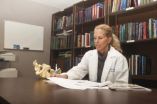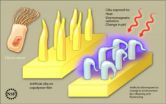(Press-News.org) Researchers at Mount Sinai School of Medicine have found that the costs of care for patients with cancer who disenrolled from hospice were nearly five times higher than for patients who remained with hospice. Patients who disenroll from hospice are far more likely to use emergency department care and be hospitalized. The results are published in the October 1 issue of the Journal of Clinical Oncology.
Led by Melissa D.A. Carlson, PhD, Assistant Professor of Geriatrics and Palliative Medicine, and Elizabeth H. Bradley, PhD, Professor of Public Health at Yale University, the research team evaluated data from 90,826 patients with cancer served by 1,384 hospices in the Surveillance, Epidemiology and End Results (SEER)-Medicare database between 1998 and 2002. Nearly 11 percent of these patients disenrolled from hospice care and had significantly higher health care use and costs than those who remained in hospice until death.
"Our data suggest that oncologists should be aware of the dramatic financial and physical toll that disenrolling from hospice can have on a patient with cancer," said Dr. Carlson. According to Dr. Bradley, "We do not really understand why some patients disenroll from hospice, especially as many had conditions that typically fit hospice care. The number was higher than we expected and would be good to investigate further." The paper recommends that oncologists should connect with palliative care teams where available and try to ensure that the patient and family are supported following hospice disenrollment."
The researchers found that 33.9 percent of the patients who had disenrolled from hospice care were admitted to an emergency department, while only 3.1 percent of those who remained in hospice care until death were. Additionally, 39.8 percent of disenrolled patients were admitted to the hospital as an inpatient where only 1.6 percent of enrolled patients were. Disenrolled patients also spent an average of 19.3 days in the hospital, whereas enrolled patients spent an average of 6.7 days.
The Medicare expenditures that the researchers evaluated included hospice care, hospitalizations, physician visits, outpatient care, medical equipment and supplies, and home health care services. Patients who stayed with hospice incurred $6,537 in expenses from the time of hospice enrollment to death, while those who did not incurred $30,848 in expenses.
The study did not investigate why patients disenrolled from hospice care and does not include individuals who were enrolled in a Medicare managed care organization before hospice enrollment. The researchers recommend that future studies include patient and caregiver interviews to help understand the hospice disenrollment process.
"Currently, 39 percent of decedents in this country were under the care of a hospice," continued Dr. Carlson. "Rather than focusing on how to decrease Medicare expenditures by restricting access to the Medicare Hospice Benefit, policy makers should focus on how to decrease the potential barriers to remaining enrolled with hospice until death, with an eye to both decreasing Medicare costs and potentially improving patient and family outcomes."
###
Co-authors on the study were Drs. Jeph Herrin, Andrew J. Epstein, Colleen L. Barry, R. Sean Morrison, Anthony L. Back, and Ms. Qingling Du.
About The Mount Sinai Medical Center
The Mount Sinai Medical Center encompasses both The Mount Sinai Hospital and Mount Sinai School of Medicine. Established in 1968, Mount Sinai School of Medicine is one of few medical schools embedded in a hospital in the United States. It has more than 3,400 faculty in 32 departments and 15 institutes, and ranks among the top 20 medical schools both in National Institute of Health funding and by U.S. News & World Report. The school received the 2009 Spencer Foreman Award for Outstanding Community Service from the Association of American Medical Colleges.
The Mount Sinai Hospital, founded in 1852, is a 1,171-bed tertiary- and quaternary-care teaching facility and one of the nation's oldest, largest and most-respected voluntary hospitals. In 2009, U.S. News & World Report ranked The Mount Sinai Hospital among the nation's top 20 hospitals based on reputation, patient safety, and other patient-care factors. Nearly 60,000 people were treated at Mount Sinai as inpatients last year, and approximately 530,000 outpatient visits took place.
For more information, visit www.mountsinai.org. Follow us on Twitter @mountsinainyc.
END
A non-stick coating for a substance found in semen dramatically lowers the rate of infection of immune cells by HIV a new study has found.
The new material is a potential ingredient for microbicides designed to reduce transmission of HIV, a team from the University of Rochester Medical Center and the University of California, San Diego reports in a forthcoming issue of the Journal of Biological Chemistry.
The coating clings to fibrous strings and mats of protein called SEVI–for semen-derived enhancer of viral infection–which was first discovered just three years ago. ...
Like a well-crafted football play designed to block the opposing team's offensive drive to the end zone, the body constantly executes complex 'plays' or sequences of events to initiate, or block, different actions or functions.
Scientists at the University of Rochester Medical Center recently discovered a potential molecular playbook for blocking cardiac hypertrophy, the unwanted enlargement of the heart and a well-known precursor of heart failure. Researchers uncovered a specific molecular chain of events that leads to the inhibition of this widespread risk factor. ...
Troy, N.Y. – Individuals within a networked system coordinate their activities by communicating to each other information such as their position, speed, or intention. At first glance, it seems that more of this communication will increase the harmony and efficiency of the network. However, scientists at Rensselaer Polytechnic Institute have found that this is only true if the communication and its subsequent action are immediate.
Using statistical physics and network science, the researchers were able to find something very fundamental about synchronization and coordination: ...
In research led by a Saint Louis University surgeon, investigators found that women who give birth after suffering pelvic fractures receive C-sections at more than double normal rates despite the fact that vaginal delivery after such injuries is possible. In addition, women reported lingering, yet often treatable, symptoms following their pelvic fracture injuries, from urinary complications to post-traumatic stress disorder.
The study, published in Clinical Orthopaedics and Related Research, retrospectively reviewed the cases of 71 women who had suffered pelvic fractures, ...
PASADENA, Calif.—Computers, light bulbs, and even people generate heat—energy that ends up being wasted. With a thermoelectric device, which converts heat to electricity and vice versa, you can harness that otherwise wasted energy. Thermoelectric devices are touted for use in new and efficient refrigerators, and other cooling or heating machines. But present-day designs are not efficient enough for widespread commercial use or are made from rare materials that are expensive and harmful to the environment.
Researchers at the California Institute of Technology (Caltech) ...
RENO, Nev. – Like the little engine that could, the University of Nevada, Reno experiment to transform wastewater sludge to electrical power is chugging along, dwarfed by the million-gallon tanks, pipes and pumps at the Truckee Meadows Water Reclamation Facility where, ultimately, the plant's electrical power could be supplied on-site by the process University researchers are developing.
"We are very pleased with the results of the demonstration testing of our research," Chuck Coronella, principle investigator for the research project and an associate professor of chemical ...
WASHINGTON– In recent decades, the rate at which humans worldwide are pumping dry the vast underground stores of water that billions depend on has more than doubled, say scientists who have conducted an unusual, global assessment of groundwater use.
These fast-shrinking subterranean reservoirs are essential to daily life and agriculture in many regions, while also sustaining streams, wetlands, and ecosystems and resisting land subsidence and salt water intrusion into fresh water supplies. Today, people are drawing so much water from below that they are adding enough ...
University of Southern Mississippi scientists recently imitated Mother Nature by developing, for the first time, a new, skinny-molecule-based material that resembles cilia, the tiny, hair-like structures through which organisms derive smell, vision, hearing and fluid flow.
While the new material isn't exactly like cilia, it responds to thermal, chemical, and electromagnetic stimulation, allowing researchers to control it and opening unlimited possibilities for future use.
This finding is published in today's edition of the journal Advanced Functional Materials. The ...
Archaeologists who interpret Stone Age culture from discoveries of ancient tools and artifacts may need to reanalyze some of their conclusions.
That's the finding suggested by a new study that for the first time looked at the impact of water buffalo and goats trampling artifacts into mud.
In seeking to understand how much artifacts can be disturbed, the new study documented how animal trampling in a water-saturated area can result in an alarming amount of disturbance, says archaeologist Metin I. Eren, a graduate student at Southern Methodist University, Dallas, and ...
University of California, Berkeley, and Yale University scientists have recreated the tremendous pressures and high temperatures deep in the Earth to resolve a long-standing puzzle: why some seismic waves travel faster than others through the boundary between the solid mantle and fluid outer core.
Below the earth's crust stretches an approximately 1,800-mile-thick mantle composed mostly of a mineral called magnesium silicate perovskite (MgSiO3). Below this depth, the pressures are so high that perovskite is compressed into a phase known as post-perovskite, which comprises ...






